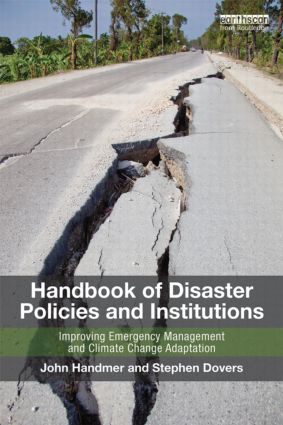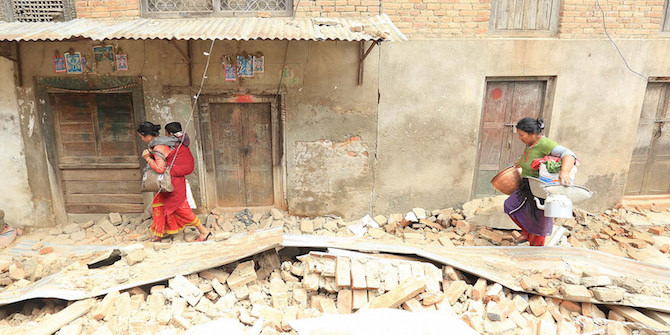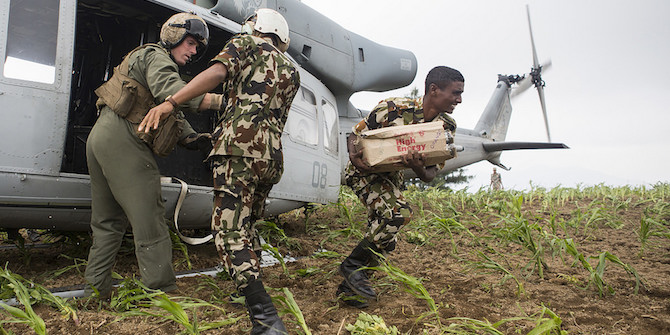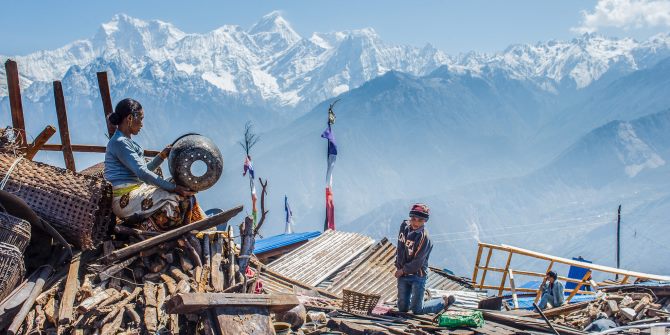This book encourages the reader to think thoroughly about the dichotomy of “policy-as-usual” vs. “emergencies-as-exceptions”, and how is it possible to plan and prepare for ‘unexpected’ natural disasters, writes Sarah Lester. However, although the book will be useful to policymakers to think critically about preparing long-term disaster response strategies, it does not provide enough of a ‘handbook’ for practicing emergency managers or humanitarian responders who need practical and considered advice on how to embed adaptive practices within their recovery strategies.
Handbook of Disaster Policies and Institutions: Improving Emergency Management and Climate Change Adaptation, 2nd Edition. John Handmer and Stephen Dovers. Routledge. 2013.
 Potentially this will be a book with a bit of difference: a move away from some of the polemic discussions so often seen in the climate change field, to a more practical ‘handbook’ designer for practitioners. Handmer and Dovers aim to provide us with mechanisms to improve emergency management and embed climate change thinking into long-term disaster response strategies.
Potentially this will be a book with a bit of difference: a move away from some of the polemic discussions so often seen in the climate change field, to a more practical ‘handbook’ designer for practitioners. Handmer and Dovers aim to provide us with mechanisms to improve emergency management and embed climate change thinking into long-term disaster response strategies.
The book starts and ends well, with a focus on resilience, preparedness strategies, and a strong description of the links between extreme climate and weather events and disasters. The logic linking these topics is threefold: firstly, natural events are often the core business of emergency response; secondly, for practical reasons it makes sense for smaller states to integrate disaster response and adaptation; and thirdly, there is an ideological economic argument that no-regrets investment is a good idea.
On the difficult issue of linking individual disasters and whether they are caused by climate change, the authors do a perfectly adequate job of sourcing literature supporting their claims and noting that the scientific link is “of little relevance to emergency managers when responding, as they do what they can regardless of the source of the event. The relevance [of climate change] comes when thinking about the future”. They make clear that this shouldn’t mean abandoning climate science or mitigation strategies, but we should now consider how to integrate adaptive planning into our disaster relief and recovery efforts.
At the heart of the book we are made to think thoroughly about the dichotomy of “policy-as-usual” vs. “emergencies-as-exceptions”, and how is it possible to plan and prepare for ‘unexpected’ natural disasters. For example, why more was not invested in earth-quake prone Nepal to help mitigate some of the impacts from the recent earthquakes.
In many ways the book brings home the message that the causes of disasters are not as important as the way in which we respond. Many humanitarians believe we are entering a ‘new normal’ with increasing levels of competing disasters, in which the question is not if a new crisis will emerge but when. The authors clearly outline the message emerging from the scientific community and the IPCC that climate change is likely to worsen both the impacts of these disasters and increase the likelihood of their occurrence in the first place. With the poor being affected more extremely both in terms of deaths and economic development, “the poorer the country, the greater the proportional impact on national economies and development progress”.

So far, so good. However, this is where the authors lose their way: somewhere between the political economy theory of chapter 2 and the framing the problems section of chapter 4, the book loses its focus on what is practical and useful for the reader and what makes a good journal article for other academics. There are some useful tools included in these chapters, for example the frameworks for policy change and checklists for analysis are useful for policymakers with the time to dig out the details buried in the book. Similarly, the ‘vignettes’ provided in chapter 1 do provide some good illustrative examples of emergency management, but somehow do not highlight how these examples can be applied more widely. There is a lack of depth on the case studies generally. If included, analysis of policy instruments would be very valuable as it could enable planners to link climate adaption policies into their humanitarian response to current crises. This is all the more important at the moment, with extreme heat in South Asia killing thousands of people in May and potential impacts of El Nino looming in the coming years: planners need tools that can enable them to develop long-term adaptation strategic planning into their current responses.
Towards the end of the book we return to the themes of communities and building resilience which does provide a few useful hints as how to approach policy problems from a bottom-up community perspective: “emergency management, and to a large extent climate change adaptation, is about being resilient in the face of uncertainty … this is closely linked with the emphasis on addressing vulnerability through building capacity and resilience in communities at risk”. However, the generic and specific instruments suggested simply do not provide enough detail to bring this book into a ‘recommended read’ section.
The book is very useful for policymakers in development who want to think critically about the work they do and how to improve it. However, it is of considerably less use to practicing emergency managers or humanitarian responders who need practical and considered advice on how to embed adaptive practices within their recovery strategies. The central question of which audience the authors are trying to convince and to what ends, looms large by the end of the book. As does the ‘how disastrous a future’ question poses in chapter 9. Faced with seemingly increasing numbers of disasters, and increasingly dire impacts of climate change, unfortunately this book does not provide enough of a ‘handbook’ to really allow governments or humanitarian actors to respond with resilient strategies.
This article forms part of our Nepal Earthquake Anniversary series. Read further posts here.
This post originally appeared on LSE Review of Books. It gives the views of the author, and not the position of the South Asia @ LSE blog, nor of the London School of Economics. Please read our comments policy before posting.
About the Author
Sarah Lester is Regional Climate and Energy Adviser for South Asia at the UK Department for International Development (DFID). All blog pieces are written in her personal capacity. Prior to working for DFID, Sarah was Research and Policy Impact Analyst at the Grantham Institute, Imperial College London. Working for the past nine years in the climate and energy sectors she has also held previous positions with the Climate Policy Initiative based at the German Institute for Economic Research (DIW Berlin) and the Electricity Policy Research Group at the University of Cambridge. Her research interests include renewable energy policies in developing countries, building resilience during humanitarian emergencies, and international and UK climate mitigation policy. Sarah currently lives and works in New Delhi, India.







